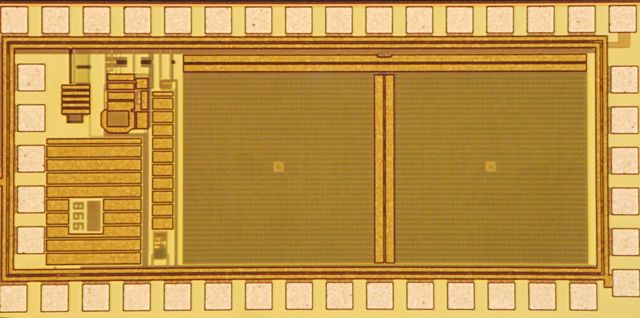Planar Fourier capture array on:
[Wikipedia]
[Google]
[Amazon]
 A planar Fourier capture array (PFCA) is a tiny camera that requires no mirror, lens, focal length, or moving parts.P. R. Gill, C. Lee, D.-G. Lee, A. Wang, and A. Molnar, "A microscale camera using direct fourier-domain scene capture," Opt. Lett., vol. 36, no. 15, pp. 2949–2951, Aug. 2011.
A planar Fourier capture array (PFCA) is a tiny camera that requires no mirror, lens, focal length, or moving parts.P. R. Gill, C. Lee, D.-G. Lee, A. Wang, and A. Molnar, "A microscale camera using direct fourier-domain scene capture," Opt. Lett., vol. 36, no. 15, pp. 2949–2951, Aug. 2011.
/ref>P. R. Gill, C. Lee, S. Sivaramakrishnan, and A. Molnar, "Robustness of planar fourier capture arrays to color changes and lost pixels," Journal of Instrumentation, vol. 7, no. 01, 2012.
/ref> It is composed of angle-sensitive pixels, which can be manufactured in unmodified CMOS processes. Angle-sensitive pixels have a sensitivity to light that is sinusoidal in incident angle along the optically-sensitive axis,A. Wang, P. Gill, and A. Molnar, "Light field image sensors based on the talbot effect," Applied Optics, vol. 48, no. 31, pp. 5897–5905, 2009.
/ref> which can be interpreted as measuring one component of the 2D Fourier transform of the far-away scene. By making them all unique, each sensor of the PFCA relates a distinct component of the 2D Fourier transform of the far-away scene, and together they relate full Fourier information. Original images are reconstructed computationally after acquisition, or if raw Fourier coefficients are more useful for the application at hand, they are used directly. PFCAs do not perform an exact Fourier transform since outputs are real-valued and are not perfect sinusoidal transforms of the image. The transform is closer to a
 A planar Fourier capture array (PFCA) is a tiny camera that requires no mirror, lens, focal length, or moving parts.P. R. Gill, C. Lee, D.-G. Lee, A. Wang, and A. Molnar, "A microscale camera using direct fourier-domain scene capture," Opt. Lett., vol. 36, no. 15, pp. 2949–2951, Aug. 2011.
A planar Fourier capture array (PFCA) is a tiny camera that requires no mirror, lens, focal length, or moving parts.P. R. Gill, C. Lee, D.-G. Lee, A. Wang, and A. Molnar, "A microscale camera using direct fourier-domain scene capture," Opt. Lett., vol. 36, no. 15, pp. 2949–2951, Aug. 2011./ref>P. R. Gill, C. Lee, S. Sivaramakrishnan, and A. Molnar, "Robustness of planar fourier capture arrays to color changes and lost pixels," Journal of Instrumentation, vol. 7, no. 01, 2012.
/ref> It is composed of angle-sensitive pixels, which can be manufactured in unmodified CMOS processes. Angle-sensitive pixels have a sensitivity to light that is sinusoidal in incident angle along the optically-sensitive axis,
/ref> which can be interpreted as measuring one component of the 2D Fourier transform of the far-away scene. By making them all unique, each sensor of the PFCA relates a distinct component of the 2D Fourier transform of the far-away scene, and together they relate full Fourier information. Original images are reconstructed computationally after acquisition, or if raw Fourier coefficients are more useful for the application at hand, they are used directly. PFCAs do not perform an exact Fourier transform since outputs are real-valued and are not perfect sinusoidal transforms of the image. The transform is closer to a
Hartley transform
In mathematics, the Hartley transform (HT) is an integral transform closely related to the Fourier transform (FT), but which transforms real-valued functions to real-valued functions. It was proposed as an alternative to the Fourier transform by R ...
, but even this correspondence is not exact. Still, the mathematics underlying completeness of the Fourier transform are useful in designing and understanding PFCAs.
Because PFCAs do not require focusing optics or moving parts, they can be made smaller than the smallest focusing camera. Counting only the active portions of the PFCA (and not the structural substrate giving it physical robustness), PFCAs are a factor of 105 smaller than the smallest focusing camera by volume.
See also
*Charge-coupled device
A charge-coupled device (CCD) is an integrated circuit containing an array of linked, or coupled, capacitors. Under the control of an external circuit, each capacitor can transfer its electric charge to a neighboring capacitor. CCD sensors are a ...
* Active pixel sensor
*Superlens A superlens, or super lens, is a lens which uses metamaterials to go beyond the diffraction limit. For example, in 1995, Guerra combined a transparent grating having 50nm lines and spaces (the "metamaterial") with a conventional microscope immersio ...
References
{{reflist Fourier analysis Image sensors